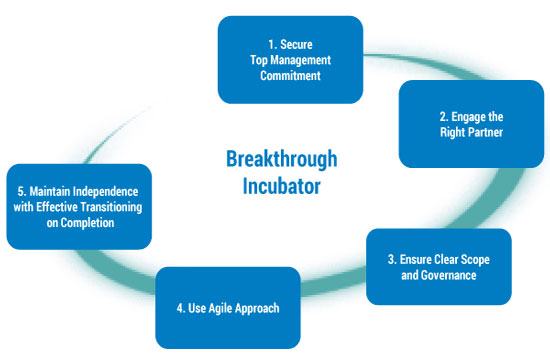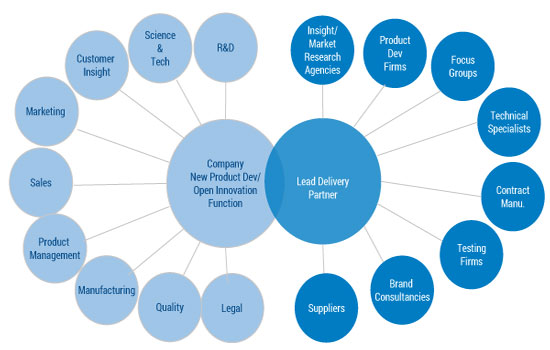In this Advisor, we explore the implementation of a promising breakthrough growth model that we have successfully applied in both B2C and B2B businesses. This model delivers major benefits in terms of speed, cost, and likelihood of success. It involves radical collaboration across the innovation ecosystem and covers the entire innovation process from idea to commercialization, including the strategic, commercial, operational, and technical aspects.
The Breakthrough Incubator (BI) model provides an excellent means of overcoming the real challenges of breakthrough innovation. To achieve its benefits, the BI approach must be appropriately implemented. We have identified five key success factors to get to that win (see Figure 1).

1. Secure Top Management Commitment
The BI model will not work unless it is actively sponsored by top management. An end-to-end innovation program cuts across many different functions, not just R&D. There are inevitably many vested interests and perceived threats across these functions: not only internal technical resources who may view the BI model as a possible threat, but also those people in such functions and disciplines as marketing, supply chain, manufacturing, and strategic planning, who initially may be suspicious or skeptical. Indeed, top management leverage and authority are necessary to push the model through without undue interference from internal stakeholders.
2. Engage the Right Partner
The role of the BI partner is central to the model’s success. The BI partner acts as an overall “orchestrator” for the program, using both its own resources and those of the ecosystem (see Figure 2). The company must ensure that there is a single-focal-point guidance team during execution, typically within the new product development or open innovation function, which can orchestrate the involvement of other company functions. The BI partner firm must have relevant in-depth expertise in-house. This means having experienced staff with first-hand experience in new product/service development in the appropriate industry. Both the guidance team and the BI partner, together, should bring a mix of detailed technical skills (e.g., in appropriate technologies), operational skills (e.g., in relevant manufacturing, sourcing, and/or supply chain operations), commercial and marketing skills (e.g., in pricing, brand strategy, and channel strategy), and strategic business skills (e.g., in growth strategy). It is essential that the BI partner is involved as a player as well as an orchestrator, working closely with other specialist partners at a detailed level. Without this, the BI partner role is reduced to one of an administrator or project manager, and this provides an insufficient level of control for a complex innovation program. This multidisciplinary capability is vital for the BI partner. As an example, a purely technical firm (e.g., contract design and development consultancy) may not be appropriate for the role, and neither would a purely strategic or brand/marketing consultancy.

The other specialist partners from the ecosystem should be the best available given the scope and nature of the work. Typically, some will be firms that already work regularly for the client company and are known and trusted by them, while others will be firms that have strong existing associations with the BI partner firm. Contracting should use good procurement practices, with competitive bids where appropriate. It may be relevant to have more than one partner organization in the same field working in parallel, such as in new concept development, as this can greatly enhance the richness and breadth of the outcome.
3. Ensure Clear Scope and Governance
As with any significant project, it is important to establish and agree on the scope, ambition, tasks, deliverables, and milestones clearly and with sufficient detail at the outset. It is common to have a significant degree of uncertainty at this stage; hence, we advise splitting execution into discrete phases with separate budgets. Establishing a suitable steering and governance process is also important. This should include a joint steering committee with senior executives from both the company and the BI partner, and a program-level team, comprising the BI partner firm’s program leader and the company’s day-to-day focal point.
4. Use Agile Approach
As mentioned, the BI model delivers benefits, especially through speed and agility. Thus, the development process needs to be based on deep, comprehensive technology and market/customer insight. Subsequent steps from concept development onwards need to be conducted iteratively, with early prototyping and rapid quantitative and qualitative testing in the marketplace. One of the benefits of the BI model is that it enables an Agile, multifunctional development approach, which would be hard to implement within a large global organization. Effectively, this is similar to treating the program as a new business venture with seamless integration across strategic, technical, commercial, and operational functions.
5. Maintain Independence with Effective Transitioning on Completion
One of the main benefits of the BI model for breakthrough innovation is its freedom to run without corporate interference. It follows that a key success factor is to maintain adequate independence with contacts only via the nominated focal-point guidance team and the joint steering committee, as mentioned above. In some cases, it may even be necessary to keep the program confidential within the company itself until it has reached sufficient maturity, in order to prevent corporate interference. This also helps in maintaining external confidentiality.
A consequence of this independence during execution is that it is extremely important to have a comprehensive transitioning process to integrate and hand the program back to the company upon completion. This transitioning process needs to include structured interactions with all key internal stakeholders, including elements such as one-to-one coaching, interactive workshops, coworking, and “helpline” support. Transitioning will typically need to take place over several months to provide the receiving organization within the company with adequate opportunity to assimilate and “own” the new business, as well as to benefit fully from the insight and lessons learned.
[For more from the authors on this topic, see: “The Breakthrough Incubator: A Radical Model for Innovative New Business.”]








